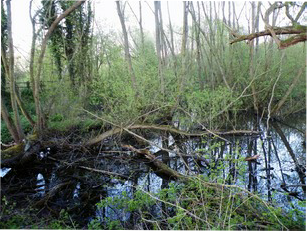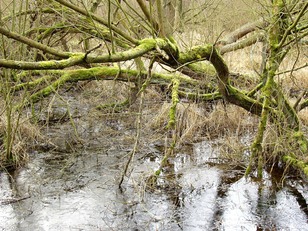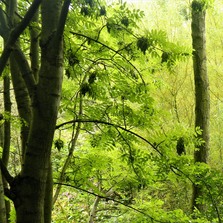

Biodiversity
Action
Plan
Wet Woodland. A jungle of deadwood and new growth from toppled trunks in waterlogged ground, ‘Willow Carr’ is an impressive extreme form of Wet Woodland.
Wet and waterlogged woods provide important habitats for biodiversity with an abundance of lichens, mosses, sedges, rushes and ferns and large numbers of invertebrates which support amphibians, mammals and birds.
Wet Woodland, well represented in Barnsley, is found near streams and hill-side flushes, and on floodplains, often in a patchwork with and replacing fens and swamps. It is found within other woodland.
It occurs on poorly drained, wet or seasonally wet soils, usually with Willows , Birches and Alder as the main trees species, but sometimes including trees like Ash where it is a little drier.
The high humidity supports rich arrays of mosses, lichens and ferns; Marsh Marigold, Opposite-leaved Golden Saxifrage, and Yellow Flag may be found alongside sedges, rushes, and reeds.
Harvest Mouse nests may be found in Reed Canary Grass (Phalaris) and Wet Woodland provides cover and breeding sites for more mammals, such as Otter, Water Vole, and bats such as Noctule.
Barnsley’s scrubby wet woodland provides a national stronghold for the endangered Willow Tit, which excavates nest holes in rotten wood; Siskin and Lesser Redpoll feed on alder catkins and birch seed; and Lesser Spotted Woodpecker frequents these wet woods.
Increasingly Wet Woodland is being recognised as a major contributor to Natural Flood Management by ‘slowing the flow’ of water into downstream areas.
For more information on Wet Woodland use the links below:
Local Priority Habitat details
Wet woodland is a local priority habitat because of its national status, the plants, animals and birds it supports, and the opportunity for its conservation in Barnsley.
Wet Woodland is a national priority habitat, UKHab w1d
It is classed as Broadleaf Woodland or Scrub in Phase 1 habitat surveys.
Wet Woodland in Barnsley includes National Vegetation Classification categories:
W2 Willow-Birch carr
W4 Birch-Purple Hairgrass
W5 Alder-Sedge woodland
W6 Alder-Nettle woodland
W7 Alder-Ash woodland.
W6a is a frequent category for willow carr with Crack Willow together with Grey Willow and Reed Canary Grass (Phalaris).
Long established Wet Woodland is particularly rich in wildlife but more recently established Wet Woodland is also valuable.
The best examples of the local priority habitat are:
- Ancient [Wet] Woodland,
- Wet Woodland with a good range of ancient woodland indicator or notable plants, or
- Wet woodland that supports good populations of species of conservation importance eg bats, birds, invertebrates.




Wet Woodland